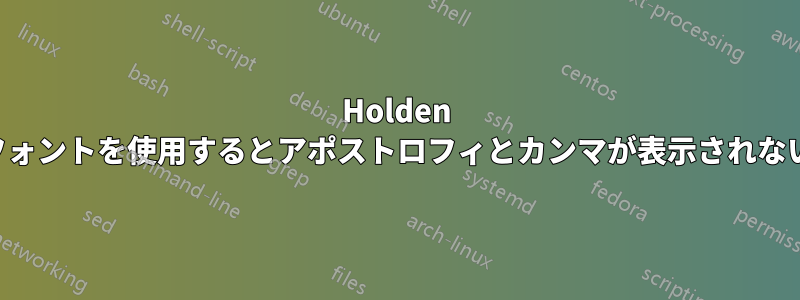
通常のフォント、たとえばデフォルトのコンピュータのモダン フォントでは、アポストロフィとカンマが出力に表示されます。しかし、Holden フォントを使用すると、\setmainfont{Holden}アポストロフィとカンマは出力に表示されません。
私のコードは -
\documentclass[12pt]{article}
\usepackage[a4paper,left=1cm,right=1cm,top=1cm,bottom=1cm]{geometry}
\usepackage{fontspec}
\usepackage[dvipsnames]{xcolor}
\usepackage[object=vectorian]{pgfornament} % also loads tikz
\setmainfont{Holden}
\tikzset{pgfornamentstyle/.style={draw = Periwinkle,
fill = SpringGreen}}
\usetikzlibrary{
positioning, % for left=of, above=of etc.
calc % for let syntax used in second example
}
\begin{document}
\begin{center}
\begin{tikzpicture}[
every node/.append style={inner sep=0},
node distance=5mm
]
\node [Black] (text){Vaijan's Honey};
\path
let
\p1=(text.south west),
\p2=(text.north east),
\n1={\x2-\x1}, % width of text node
\n2={\y2-\y1} % height of text node
in
% in all of the below some fraction of \n1 or \n2 is used to define the width of the ornaments
% set width of these ornaments to half the text node's width
node [anchor=north] (below) at (text.south) {\pgfornament[width=0.5*\n1,symmetry=c]{69}}
node [anchor=south] (above) at (text.north) {\pgfornament[width=0.5*\n1]{69}}
% use \n2 for ornament width here
node [rotate=-90, left=of text, anchor=north] (left) {\pgfornament[width=\n2]{46}}
node [rotate=90, right=of text, anchor=north] (right) {\pgfornament[width=\n2]{46}}
% and \n1 here
node [above=of above] (top) {\pgfornament[width=\n1]{71}}
node [below=of below] (bottom) {\pgfornament[width=\n1,symmetry=h]{71}}
% node [anchor=north] (top) at (text.north) {\pgfornament[width=\n1]{71}}
% node [anchor=south] (bottom) at (text.south) {\pgfornament[width=\n1,symmetry=h]{71}}
% and 25% of width for the corner ornaments
node [anchor=north west] at (top.north -| left.south) {\pgfornament[width=0.25*\n1]{63}}
node [anchor=north east] at (top.north -| right.south) {\pgfornament[width=0.25*\n1,symmetry=v]{63}}
node [anchor=south west] at (bottom.south -| left.south) {\pgfornament[width=0.25*\n1,symmetry=h]{63}}
node [anchor=south east] at (bottom.south -| right.south) {\pgfornament[width=0.25*\n1,symmetry=c]{63}}; % <- note the \path doesn't end until here
% draw frame
\draw [Blue] (current bounding box.south west) rectangle (current bounding box.north east);
\vspace{2cm};
\node [anchor=south] (bellowaddress1) at (below.south) {\pgfornament[width=0.10*\textwidth]{88}};
\setmainfont{Linux Biolinum O}
\tiny
\node [Brown, below, align=center] (bellowaddress3) at (bellowaddress1.south) {Md.Al-Helal, CSE, DU\\ 01515611989};
\node [anchor=south, below] (bellowaddress2) at (bellowaddress3.south) {\pgfornament[width=0.10*\textwidth]{88}};
\end{tikzpicture}
\end{center}
\end{document}
答え1
どうやらこのフォントのマッピングは完全には正しくありません。ログには次のように表示されます:
Missing character: There is no ’ in font [Holden.otf]/OT:mapping=tex-text;!
ただし、FontForge で確認できるように、文字は存在します。
FontForge は文字の名前を表示します。これは、文字を印刷するために使用できるインデックス番号を見つけるため"quotesingle"のマクロに使用できます。\XeTeXglyphindex
\documentclass[12pt]{article}
\usepackage{fontspec}
\setmainfont{Holden.otf}
\begin{document}
The apostrophe is at position: \the\XeTeXglyphindex"quotesingle"
Printed: \XeTeXglyph83
\end{document}
ここでは.otfフォントが使用されていますが、バージョンでも同じように機能することに注意してください.ttf。
MWE に適用:
\node [Black] (text){Vaijan\XeTeXglyph83 s Honey};
答え2
フォントはデフォルトで で読み込まれますLigatures=TeX。この機能は'U+2019 に再マップされますが、どうやら Holden フォントにはそのスロットにグリフがないようです。それどころか、標準 ASCII 位置のアポストロフィはカーリーです。
フォントをロードするだけですLigatures=TeX。
\documentclass[12pt]{article}
\usepackage[a4paper,left=1cm,right=1cm,top=1cm,bottom=1cm]{geometry}
\usepackage{fontspec}
\usepackage[dvipsnames]{xcolor}
\usepackage[object=vectorian]{pgfornament} % also loads tikz
\newfontface{\holdenfont}{Holden}[
Path=./,
Extension=.otf,
Ligatures=,
]
\tikzset{pgfornamentstyle/.style={draw = Periwinkle,
fill = SpringGreen}}
\usetikzlibrary{
positioning, % for left=of, above=of etc.
calc % for let syntax used in second example
}
\begin{document}
\begin{center}
\begin{tikzpicture}[
every node/.append style={inner sep=0},
node distance=5mm
]
\node [Black] (text){\holdenfont Vaijan's Honey};
\path
let
\p1=(text.south west),
\p2=(text.north east),
\n1={\x2-\x1}, % width of text node
\n2={\y2-\y1} % height of text node
in
% in all of the below some fraction of \n1 or \n2 is used to define the width of the ornaments
% set width of these ornaments to half the text node's width
node [anchor=north] (below) at (text.south) {\pgfornament[width=0.5*\n1,symmetry=c]{69}}
node [anchor=south] (above) at (text.north) {\pgfornament[width=0.5*\n1]{69}}
% use \n2 for ornament width here
node [rotate=-90, left=of text, anchor=north] (left) {\pgfornament[width=\n2]{46}}
node [rotate=90, right=of text, anchor=north] (right) {\pgfornament[width=\n2]{46}}
% and \n1 here
node [above=of above] (top) {\pgfornament[width=\n1]{71}}
node [below=of below] (bottom) {\pgfornament[width=\n1,symmetry=h]{71}}
% node [anchor=north] (top) at (text.north) {\pgfornament[width=\n1]{71}}
% node [anchor=south] (bottom) at (text.south) {\pgfornament[width=\n1,symmetry=h]{71}}
% and 25% of width for the corner ornaments
node [anchor=north west] at (top.north -| left.south) {\pgfornament[width=0.25*\n1]{63}}
node [anchor=north east] at (top.north -| right.south) {\pgfornament[width=0.25*\n1,symmetry=v]{63}}
node [anchor=south west] at (bottom.south -| left.south) {\pgfornament[width=0.25*\n1,symmetry=h]{63}}
node [anchor=south east] at (bottom.south -| right.south) {\pgfornament[width=0.25*\n1,symmetry=c]{63}}; % <- note the \path doesn't end until here
% draw frame
\draw [Blue] (current bounding box.south west) rectangle (current bounding box.north east);
\vspace{2cm};
\node [anchor=south] (bellowaddress1) at (below.south) {\pgfornament[width=0.10*\textwidth]{88}};
\setmainfont{Linux Biolinum O}
\tiny
\node [Brown, below, align=center] (bellowaddress3) at (bellowaddress1.south) {Md.Al-Helal, CSE, DU\\ 01515611989};
\node [anchor=south, below] (bellowaddress2) at (bellowaddress3.south) {\pgfornament[width=0.10*\textwidth]{88}};
\end{tikzpicture}
\end{center}
\end{document}
メインフォントとしてロードせず、パスと拡張子を指定して設定に合わせました(そのフォントがシステムフォントを上書きするのは絶対に避けたいです)







